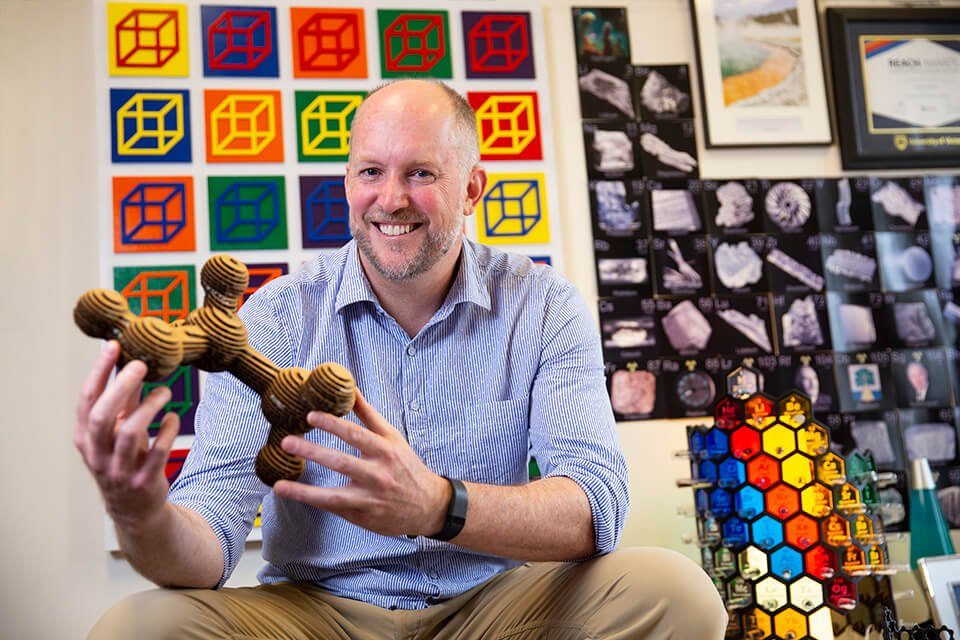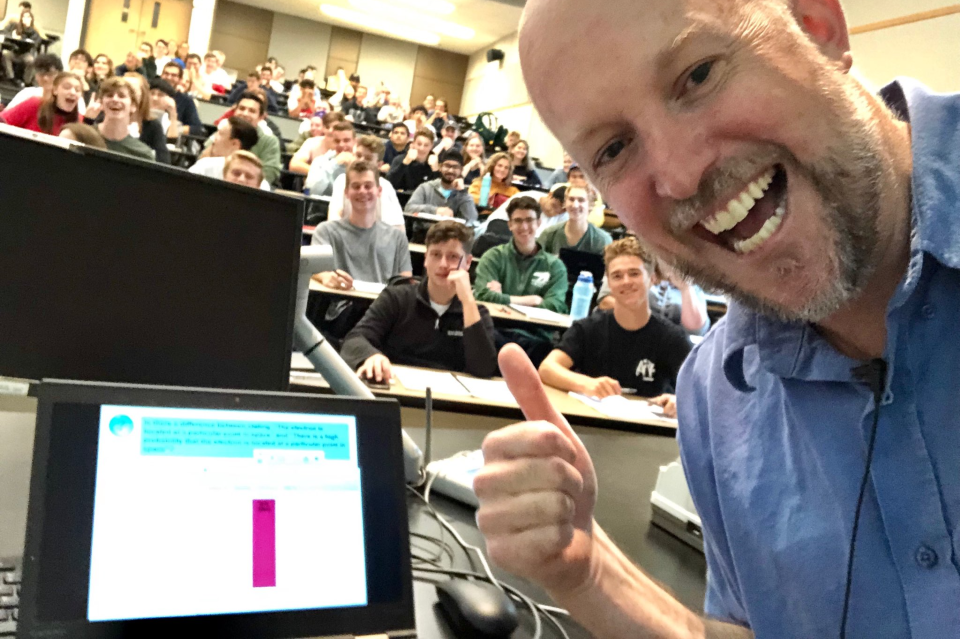Catalyzing comprehension in the classroom
- Dorothy Eggenberger

The transition from a high school to university classroom can be tricky—moving from a class size of 30 to literally hundreds. Yet, the structure of a first-year lecture stays the same. An instructor asks a question and a few students raise their hands.
“You think you have a good impression of the class and their understanding of the material,” says UVic chemistry professor Scott McIndoe. “It wasn’t until I started using clickers that I realized the majority of the class was struggling.”
Clickers are an interactive technology that enables instructors to pose questions to students and immediately collect and view the responses of the entire class. Now, instead of a handful of students, 200 or more will answer a question at the same time. McIndoe also uses Google Form for anonymous questions during class—the QR code is posted in the classroom and McIndoe receives the questions to his phone.
For his creativity, innovation and inclusiveness, McIndoe was named a 3M National Teaching Fellow this Spring—one of 10 post-secondary educators across Canada to be recognized for their exceptional leadership in undergraduate education.
Transformative teaching
McIndoe is an international expert in mass spectrometry of organometallic compounds and catalysts. Since joining UVic in 2003, he has introduced new ways of teaching chemistry and helped rejuvenate the chemistry department’s first-year course curriculum.
“I’m struck by how Scott has constantly changed his delivery and methods over the years, while also maintaining a high level of structure and organization to ensure students’ benefit,” says UVic chemist and Canada Research Chair Fraser Hof, “There are no gimmicks here—Scott is an educator who is incredibly skilled and profoundly committed to his students.”
McIndoe establishes a level of trust and engagement that keeps students coming back for more. Since he began innovating in the classroom and lab, more students than ever have signed up for—and succeeded—in higher-level chemistry courses.

Not your usual office hours
McIndoe’s key to success is focusing his efforts on improving the undergraduate experience for the larger student body, rather than showcasing star pupils. Case in point: he transformed his office hours by relocating from his office to a lecture hall. Instead of one student, he meets with anywhere from 30 to 150.
In 2020, McIndoe’s Zoom class included both live, virtual office hours as well as an online discussion forum, which housed thousands of student posts. “I appreciate how valiantly he tackled the ridiculous amounts of forum posts,” commented one student.
Volume is no deterrent for McIndoe. Also in 2020, he flipped the virtual Zoom classroom by presenting a pre-recorded Zoom lecture to engage students in a live chat during the video. A chat log for one 50-minute class was hundreds of lines long: students asking for a simple, catch-up clarification; students asking follow-ups to help form basic ideas; and students posting ideas and questions that extend the lesson to a higher level.
A signature of his Chemistry 101 class—called a ‘godsend’ by many students—is a lecture book with partially completed PowerPoint slides connected to passages in the textbook. As McIndoe lectures, he fills in missing text, numbers, and molecular diagrams on the slides, and the students do the same in their own lecture books.
“I like the way lectures are done in this course. Having the lecture book which we fill in forced me to actually participate, and had me more engaged than other courses did,” says another student.
Changing students’ minds about chemistry
McIndoe’s engaging and approachable teaching style (and perhaps also his infectious enthusiasm) combats the pervasive view that chemistry, even introductory chemistry, is harder and less approachable than other disciplines. In doing so, he opens up the field to students who may have disliked or even feared this area of science.
“Chemistry strives to answer the question ‘how do things work?’ at the deepest level comprehensible by scientists: at the level of molecules and atoms,” says McIndoe. He maintains that only by understanding molecules better can we solve today’s urgent problems.
“Clean energy. A pristine environment. Cures for cancer. How to feed the world. Sustainable manufacturing. Molecular computing. I'm not pretending that I'm going to solve any or all of these problems, but someone I teach just might, and that makes my career as a researcher and educator both hugely rewarding and a lot of fun."
—Scott McIndoe


